Regulations Amending the Canadian Forces Employment Equity Regulations: SOR/2021-201
Canada Gazette, Part II, Volume 155, Number 18
Registration
SOR/2021-201 August 12, 2021
EMPLOYMENT EQUITY ACT
P.C. 2021-871 August 11, 2021
Whereas, pursuant to paragraph 4(1)(d) of the Employment Equity Act footnote a, the Canadian Forces have been specified as a portion of the public sector employing one hundred or more employees by Order in Council P.C. 2002-1956 of November 21, 2002;
Whereas the Governor in Council, taking into account the operational effectiveness of the Canadian Forces, considers that the annexed Regulations are necessary to adapt that Act to accommodate the Canadian Forces;
And whereas, pursuant to subsection 41(6) footnote b of that Act, the Minister of National Defence has been consulted on the annexed Regulations;
Therefore, Her Excellency the Governor General in Council, on the recommendation of the Treasury Board and the Minister of Labour, pursuant to subsection 41(5) of the Employment Equity Act footnote a, makes the annexed Regulations Amending the Canadian Forces Employment Equity Regulations.
Regulations Amending the Canadian Forces Employment Equity Regulations
Amendments
1 Paragraph 4(1)(b) of the Canadian Forces Employment Equity Regulations footnote 1 is replaced by the following:
- (b) in the reserve force, other than those declared non-effective strength.
2 (1) Section 10 of the Regulations is amended by adding the following after subsection (1):
Member identification
(1.1) The questionnaire shall include questions that provide a means of identifying the Canadian Forces member who returns it, by name or otherwise.
(2) Paragraph 10(3)(a) of the Regulations is replaced by the following:
- (a) the definitions Aboriginal peoples, members of visible minorities and persons with disabilities as set out in section 3 of the Act;
(3) Paragraphs 10(3)(c) and (d) of the Regulations are replaced by the following:
- (c) a statement that responses to the questions referred to in subsection (1.1) are mandatory;
- (d) a statement that responses to the questions referred to in subsections (1) and (2) are voluntary; and
3 Section 11 of the Regulations is repealed.
4 Paragraph 19(c) of the Regulations is replaced by the following:
- (c) the military rank of each Canadian Forces member, as set out in the schedule to the National Defence Act, that determines that member's salary;
5 Subsection 22(1) of the Regulations is replaced by the following:
Security requirement
22 (1) The Canadian Human Rights Commission, any of its officers and any other person acting on behalf of or under the direction of the Commission, as well as any member of an Employment Equity Review Tribunal established under subsection 28(1) of the Act and any other person acting on behalf of or under the direction of such a Tribunal, who receives or obtains information for the purposes of the Act shall satisfy, with respect to access to and use of that information, any requirements in the regulations, orders and instructions made under the National Defence Act that relate to the security of the places to be entered or the records, books of account or other documents to be examined.
6 (1) The portion of section 27 of the Regulations before paragraph (a) is replaced by the following:
Representation by rank
27 The Chief of the Defence Staff shall provide the following information for the reporting period for each military rank set out in the schedule to the National Defence Act:
(2) Paragraphs 27(a) and (b) of the French version of the Regulations are replaced by the following:
- a) le nombre et la représentation des membres des Forces canadiennes visés à l'alinéa 4(1)a) dans le formulaire prévu à l'annexe 6;
- b) le nombre et la représentation des membres des Forces canadiennes visés à l'alinéa 4(1)b) dans le formulaire prévu à l'annexe 7.
7 Schedules 1 and 2 to the Regulations are replaced by the Schedule 1 set out in Schedule 1 to these Regulations.
8 Schedules 3 to 5 to the Regulations are replaced by the Schedules 3 to 5 set out in Schedule 2 to these Regulations.
9 Schedules 8 to 15 to the Regulations are replaced by the Schedules 8 to 15 set out in Schedule 3 to these Regulations.
10 The English version of the Regulations is amended by replacing “aboriginal” with “Aboriginal” in the following provisions:
- (a) paragraph 10(1)(a);
- (b) subparagraph 15(1)(a)(ii); and
- (c) paragraph 16(1)(a).
Coming into Force
11 These Regulations come into force on the day on which they are registered.
SCHEDULE 1
(Section 7)
SCHEDULE 1
(Subsection 1(1))
PART 1
| Item | Column 1 Military Occupational Group |
Column 2 Military Occupation |
|---|---|---|
| 1 | General Officers |
|
| 2 | Naval Operations | Naval Warfare Officer |
| 3 | Maritime Engineering |
|
| 4 | Combat Arms |
|
| 5 | Air Operations — Pilots | Pilot |
| 6 | Air Operations |
|
| 7 | Aerospace Engineering | Aerospace Engineering |
| 8 | Engineering |
|
| 9 | Medical and Dental |
|
| 10 | Chaplaincy | Chaplain |
| 11 | Support |
|
| 12 | Cadet Organizations Administration and Training Service (COATS) | Cadet Organizations Administration and Training Service (COATS) — General Service Officer |
| 13 | Canadian Rangers | Canadian Ranger (Officer) |
| 14 | Officers — Unassigned | Officer — Unassigned |
| 15 | Officer Cadets — Unassigned | Officer Cadet — Unassigned |
PART 2
| Item | Column 1 Military Occupational Group |
Column 2 Military Occupation |
|---|---|---|
| 1 | Naval Operations |
|
| 2 | Maintenance — Naval |
|
| 3 | Combat Arms |
|
| 4 | Air Operations — Transmissions |
|
| 5 | Air Technicians |
|
| 6 | Military Police | Military Police |
| 7 | Operations — General |
|
| 8 | Communications and Electronics Maintenance |
|
| 9 | Medical |
|
| 10 | Dental | Dental Technician |
| 11 | Electrical and Mechanical |
|
| 12 | Military Engineers |
|
| 13 | Clerical Personnel |
|
| 14 | Music |
|
| 15 | Logistical Support |
|
| 16 | Senior Appointments | Chief Petty Officer First Class/Chief Warrant Officer CORPS |
| 17 | Cadet Organizations Administration and Training Service (COATS) | Cadet Organizations Administration and Training Service (COATS) — General Service NCM |
| 18 | Canadian Rangers | Canadian Ranger (NCM) |
| 19 | Primary Reserve General Service for Non-Commissioned Members | Primary Reserve General Service for Non-Commissioned Members |
SCHEDULE 2
(Section 8)
SCHEDULE 3
(Section 23, paragraph 25(a) and section 26)
PART 1
Military Occupational Groups — Officers, Regular Force (Paragraph 4(1)(a))

PART 2
Military Occupational Groups — Non-Commissioned Members, Regular Force (Paragraph 4(1)(a))
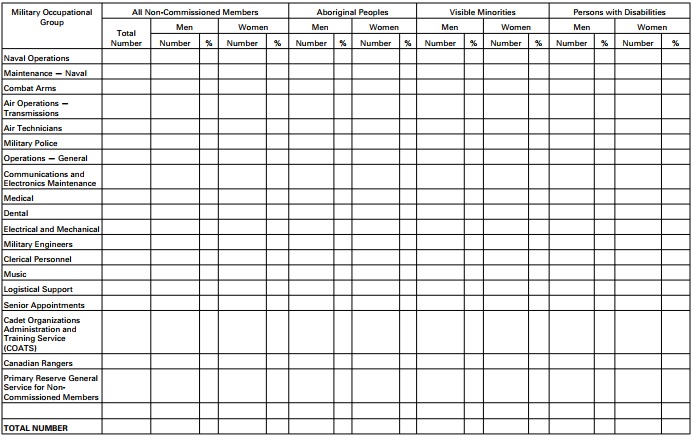
SCHEDULE 4
(Section 23, paragraph 25(b) and section 26)
PART 1
Military Occupational Groups — Officers, Reserve Force (Paragraph 4(1)(b))
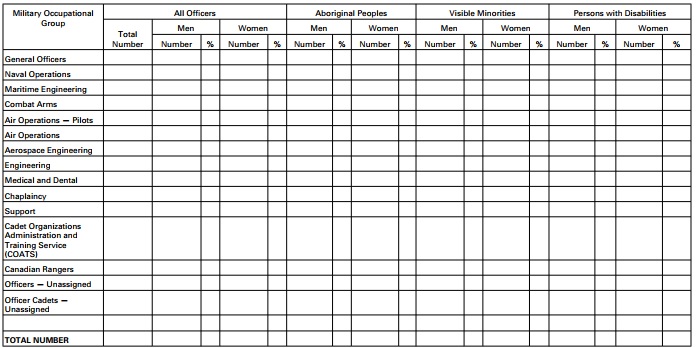
PART 2
Military Occupational Groups — Non-Commissioned Members, Reserve Force (Paragraph 4(1)(b))
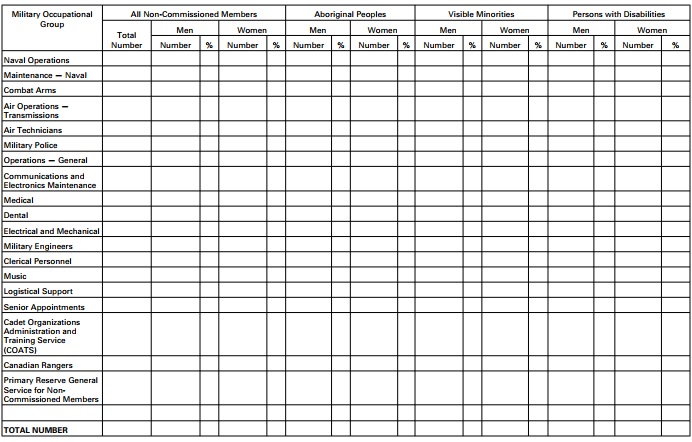
SCHEDULE 5
(Sections 23, 24 and 26)
PART 1
Military Occupational Groups — Officers (Subsection 4(1))
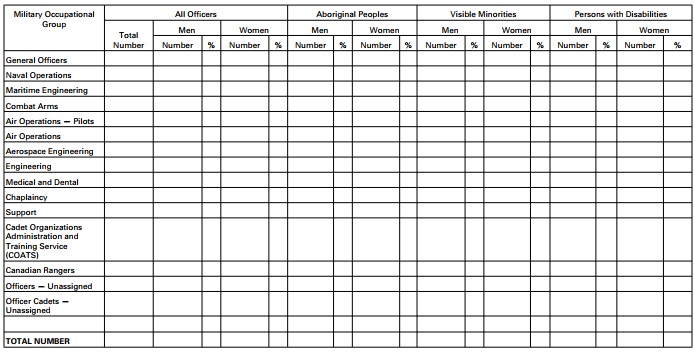
PART 2
Military Occupational Groups — Non-Commissioned Members (Subsection 4(1))
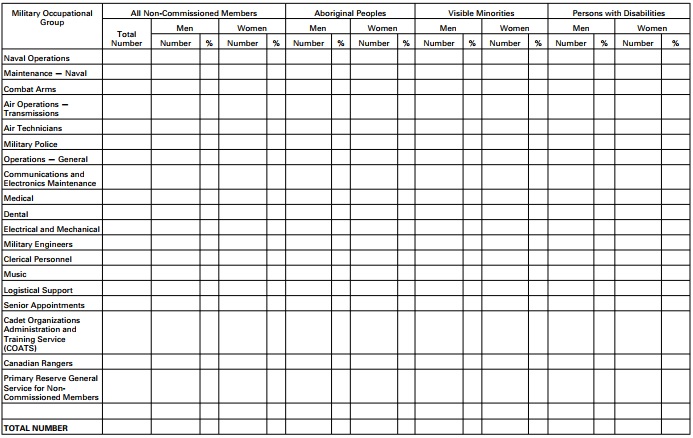
SCHEDULE 3
(Section 9)
SCHEDULE 8
(Sections 23 and 26 and paragraph 28(1)(a))
PART 1
Enrolments — Officers, Regular Force (Paragraph 4(1)(a))
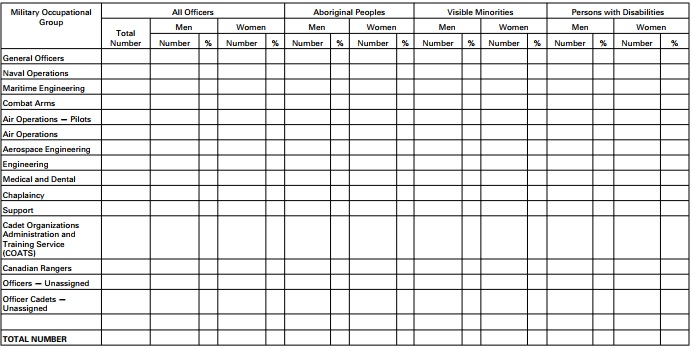
PART 2
Enrolments — Non-Commissioned Members, Regular Force (Paragraph 4(1)(a))

SCHEDULE 9
(Sections 23 and 26 and paragraph 28(2)(a))
PART 1
Enrolments — Officers, Reserve Force (Paragraph 4(1)(b))

PART 2
Enrolments — Non-Commissioned Members, Reserve Force (Paragraph 4(1)(b))
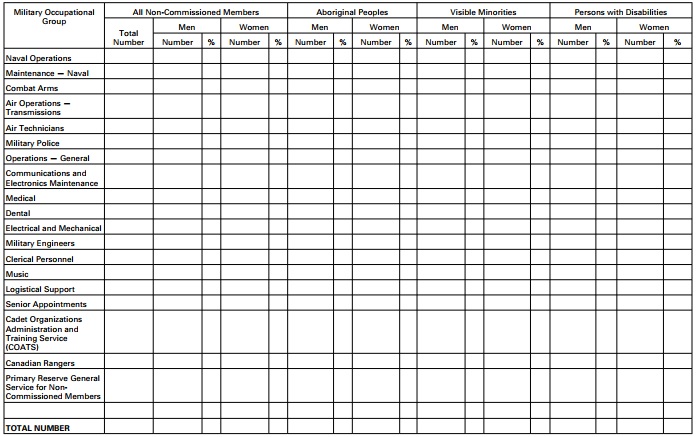
SCHEDULE 10
(Sections 23 and 26 and paragraph 28(1)(b))
PART 1
Promotions — Officers, Regular Force (Paragraph 4(1)(a))

PART 2
Promotions — Non-Commissioned Members, Regular Force (Paragraph 4(1)(a))
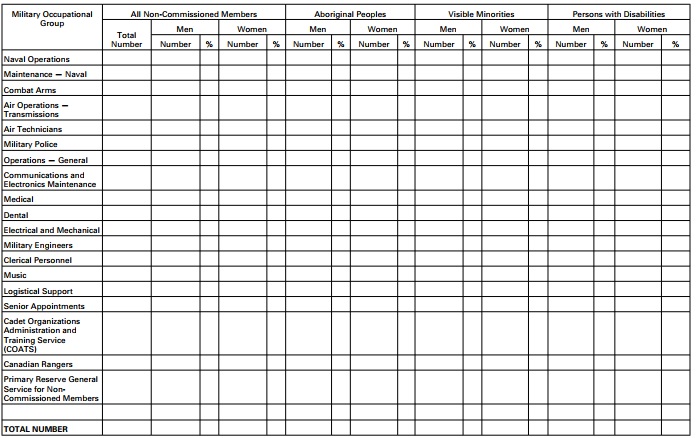
SCHEDULE 11
(Sections 23 and 26 and paragraph 28(2)(b))
PART 1
Promotions — Officers, Reserve Force (Paragraph 4(1)(b))
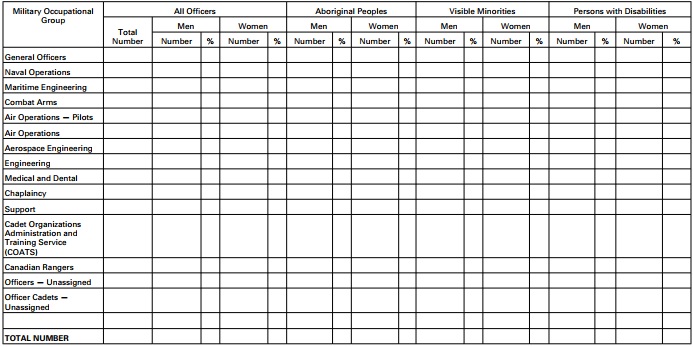
PART 2
Promotions — Non-Commissioned Members, Reserve Force (Paragraph 4(1)(b))
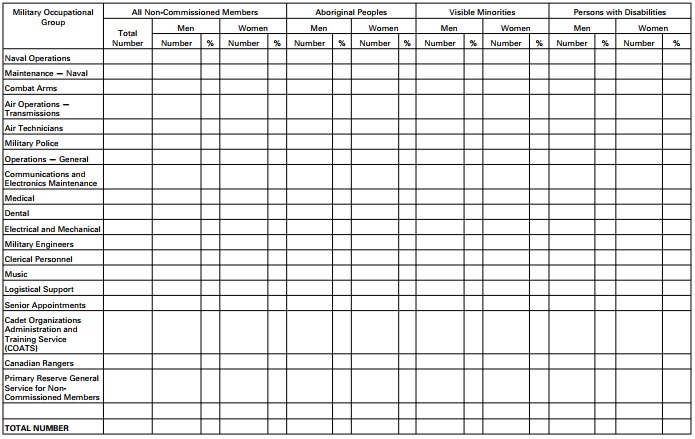
SCHEDULE 12
(Sections 23 and 26 and paragraph 28(1)(c))
PART 1
Re-Engagements — Officers, Regular Force (Paragraph 4(1)(a))
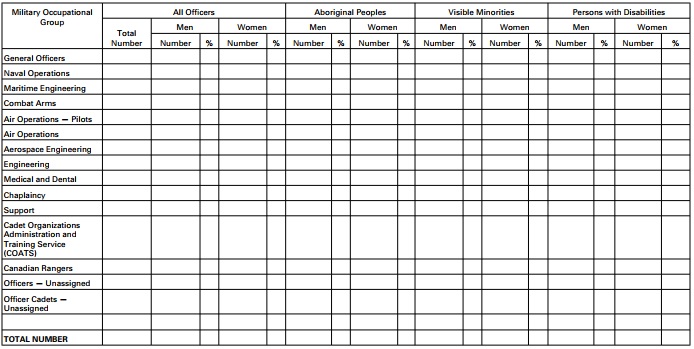
PART 2
Re-Engagements — Non-Commissioned Members, Regular Force (Paragraph 4(1)(a))
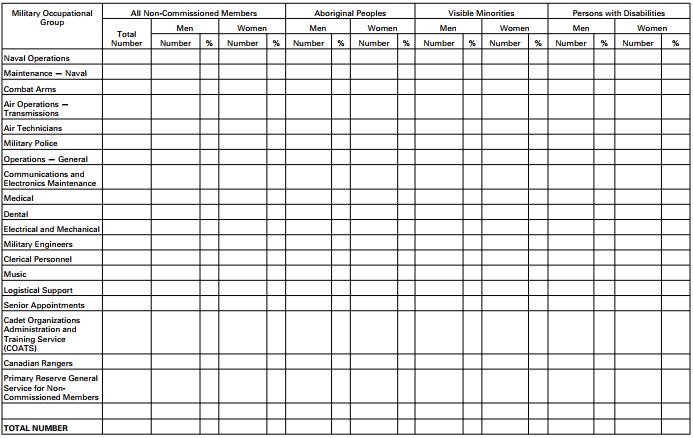
SCHEDULE 13
(Sections 23 and 26 and paragraph 28(2)(c))
PART 1
Re-Engagements — Officers, Reserve Force (Paragraph 4(1)(b))

PART 2
Re-Engagements — Non-Commissioned Members, Reserve Force (Paragraph 4(1)(b))
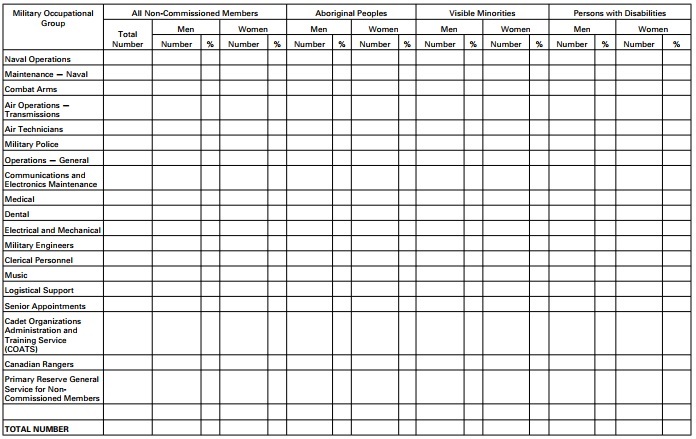
SCHEDULE 14
(Sections 23 and 26 and paragraph 28(1)(d))
PART 1
Releases — Officers, Regular Force (Paragraph 4(1)(a))
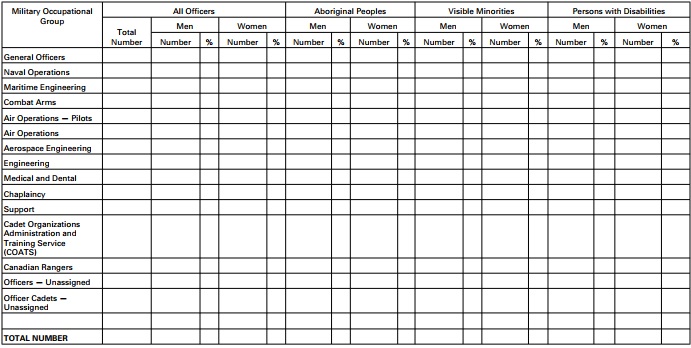
PART 2
Releases — Non-Commissioned Members, Regular Force (Paragraph 4(1)(a))
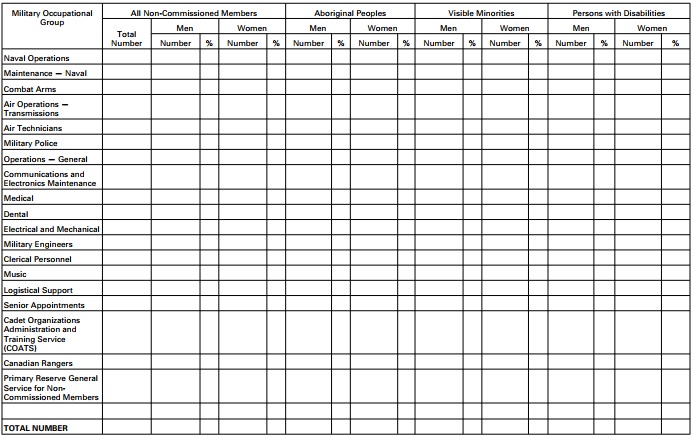
SCHEDULE 15
(Sections 23 and 26 and paragraph 28(2)(d))
PART 1
Releases — Officers, Reserve Force (Paragraph 4(1)(b))
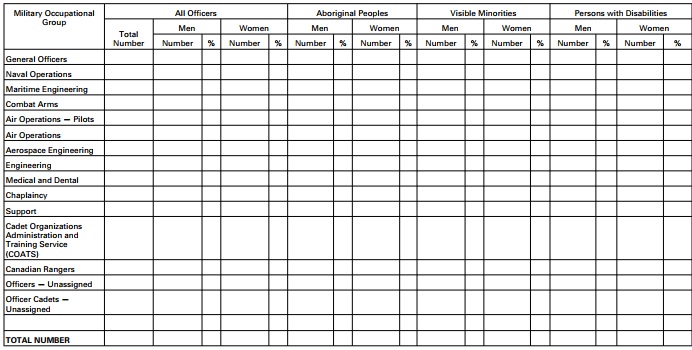
PART 2
Releases — Non-Commissioned Members, Reserve Force (Paragraph 4(1)(b))
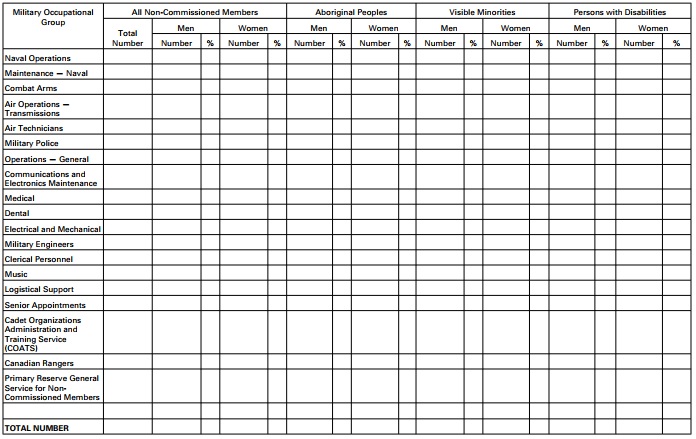
REGULATORY IMPACT ANALYSIS STATEMENT
(This statement is not part of the Regulations.)
Issues
The Employment Equity Act (the Act) came into effect in 1986. It aims to achieve equitable representation in federally regulated workplaces for four designated groups: women, Aboriginal peoples, persons with disabilities and members of visible minorities. The Act covers federally regulated private-sector employers, Crown corporations, the federal public service, separate employers (e.g. Canada Revenue Agency [CRA] and Parks Canada [PC]), as well as the Royal Canadian Mounted Police (RCMP) and the Canadian Forces (CF). Employers covered under the Act have four core obligations in implementing employment equity: to survey their workforces and collect employment representation data; to carry out analysis of under-representation of the designated groups; to review their employment systems, policies and practices in order to identify employment barriers; and to prepare plans to achieve employment equity.
The Canadian Forces Employment Equity Regulations (the CF Regulations) adapt the provisions of the Act to take into account the operational effectiveness of the CF.
Reviews of the CF Regulations by the Standing Joint Committee for the Scrutiny of Regulations (SJCSR) in 2007, and the CF in 2008, identified a number of issues:
- employment equity reporting excludes certain Reserve Force members;
- legal and compliance risks exist with respect to the handling of information by the Canadian Human Rights Commission (CHRC), the Employment Equity Review Tribunal and their officers or agents due to the reference to “any national security requirements” in paragraph 22(1)(b);
- occupational groups are not up to date; and
- the overall clarity and consistency of the CF Regulations need improvement.
Objective
The Regulations Amending the Canadian Forces Employment Equity Regulations (the Regulations) address the issues identified by the SJCSR and the CF, ensuring that the CF Regulations are applicable to all Reserve Force members, and are legally sound, clear, up to date and consistent.
Description
The CF Regulations will be amended as described in the following sections.
CF members — Reserve Force
The CF Regulations only apply to members in the Reserve Force that, as of March 31 in the reporting period, were paid for 75 days or more of reserve service. The amendments will broaden the definition of CF members by removing this reference to the number of days paid, which will make it inclusive of all CF members other than those declared non-effective strength.
Security requirements
Paragraph 22(1)(b) of the CF Regulations was removed, as the Act and the CF Regulations contain sufficient direction on handling requirements to protect national security concerns during a compliance audit or any review under the direction of the CHRC or an Employment Equity Review Tribunal, such that an additional specific provision is not required.
Designated groups
The Regulations replace the term “aboriginal” with “Aboriginal” in each instance within the English version to align the text with the Act.
Mandatory use of definitions
Before preparing the employment equity plan, the CF Regulations require the Chief of Defence Staff to conduct a voluntary workforce survey using a self-identification questionnaire. The questionnaire must contain the definitions for “Aboriginal peoples,” “persons with disabilities,” and “members of visible minorities” as they are set out in the Act, or a description of those expressions that is consistent with the definitions set out in the Act. This means that the definitions could be modified in the questionnaire, leading to inconsistencies in self-identification data.
The amendments ensure that only the definitions set out in the Act can be used in the questionnaire.
Schedule 2 — workforce survey questionnaire
Schedule 2, the sample workforce survey questionnaire, is no longer required because of the changes to the mandatory use of definitions in the questionnaire; therefore, it was removed from the Regulations.
Employment equity records
References to “column I” were removed from the Regulations to reflect updates to the schedule of the National Defence Act made in 2015.
Schedules 1, 3 to 5 and 8 to 15
Schedules 1, 3 to 5 and 8 to 15 use outdated military occupations. The amendments replaced the list of military occupational groups to address the changes to military occupations that have taken place between the coming into force of the CF Regulations in 2002 and February 2021 (e.g. removing occupations that no longer exist, updating occupation titles, and adding new occupations).
Schedule 5
The amendments update Schedule 5 by including a reference to section 26 (i.e. military occupational group of CF members), which was missing from the CF Regulations.
Regulatory development
Consultation
The CF were consulted throughout the regulatory process, including on the issue regarding the description of Reserve Force service raised by the CF in their review of the CF Regulations, and were in agreement with the draft amendments. CF members from the Directorate of General Defence Security, the Directorate of Human Rights and Diversity, as well as legislative counsels from the National Defence Regulations Section of the Department of Justice, were involved in the discussions with the Labour Program of the Department of Employment and Social Development (ESD-Labour). Broader consultations were not conducted, as the proposed amendments do not unduly affect other areas or sectors.
Given their role as the compliance and enforcement authority in reviewing CF employment equity measures, the CHRC was consulted in 2012–2013 and was in agreement with the proposed amendments to the treatment and handling of the sensitive information section of the CF Regulations.
Consultations on the other provisions were not undertaken, nor were the amendments prepublished in the Canada Gazette, Part I, as they are administrative in nature and have no impact other than on clarity.
Instrument choice
These amendments are administrative in nature and are specific to the CF Regulations; no other instrument choice was available to address these issues.
Regulatory analysis
Benefits and costs
The amendments address issues identified by the SJCSR and the CF following their respective reviews of the CF Regulations.
They also address issues identified in the previous definition of “CF members,” which only captured a portion of the Reserve Force for employment equity reporting purposes. It failed to recognize the unique nature of Reserve service in the CF and the enduring employer/employee relationship, which exists until release from the CF, notwithstanding whether or not 75 paid days is achieved over a 12-month period. Broadening the description of the “CF members” ensures Reservists, who are members of the CF, are included in the calculation of the overall employment equity representation. It is anticipated that representation rates within the CF will demonstrate positive changes in future annual reports.
Removing paragraph 22(1)(b) minimizes legal and compliance risk with respect to the handling of classified/protected information by the CHRC, the Employment Equity Tribunal and their officers or agents by reducing ambiguity in the CF Regulations. The reference to any requirements in regulations, orders and instructions made under the National Defence Act covers all aspects related to national security concerns during a compliance audit or any review conducted under the direction of the CHRC or an Employment Equity Review Tribunal.
The amendments also ensure clarity of language, replace outdated terms and occupational classifications, and improve consistency within the CF Regulations. Regarding the voluntary workforce survey, officials from the CHRC have indicated that variations on the definitions are rarely accepted for the purposes of compliance assessments. In addition, the CF already use the definitions contained in the Act, therefore, the amendments are aligned with current requirements and practices.
There are no cost implications for the amendments.
Small business lens
The small business lens does not apply, as the amendments pertain only to the CF, and there are no costs to small businesses.
One-for-one rule
The one-for-one rule does not apply, as the amendments pertain only to the CF, and there is no change in administrative costs to business.
Strategic environmental assessment
In accordance with the Cabinet Directive on the Environmental Assessment of Policy, Plan and Program Proposals, a preliminary scan concluded that a strategic environmental assessment is not required.
Gender-based analysis plus (GBA+)
The CF employment equity target for women seeks to increase representation by 1% per year until it reaches their long-term representation goal of 25.1%. In addition, by 2026, the CF seek to attain long-term representation goals of 3.5% for Aboriginal peoples and 11.8% for members of visible minorities.
Prior to the amendments, only CF members who had worked more than 75 days of the year were included in the definition used to establish CF employees covered under the Act and the CF Regulations. As a result, approximately 60% of Reserve Force members could not be included as a member of a designated group for employment equity reporting purposes. These previously excluded CF members are part-time reservists and comprise a greater number of women and members of visible minorities. The resulting effect would increase the representation of visible minorities by 0.7% based on 2017–2018 CF workforce data. The representation of Aboriginal peoples would remain the same while the representation of women would only see a slight increase of less than 0.05%.
The change to the definition of CF members allows for a greater number of employees to be eligible to selfidentify for employment equity purposes. Employee self-identification information and designated groups' representation will then be analyzed and be published in the CF Annual Employment Equity Reports.
The expected result from this change is an overall increased employment equity coverage of approximately 10 000 CF members for reporting purposes. Providing a more accurate picture of diversity and representation within the CF workforce. The impact of this change will be measured in the CF Annual Employment Equity Report and monitored through internal performance management processes.
Other tools such as the Canada's National Action Plan on Women, Peace and Security (launched in 2011 and updated in 2017) and the CF's Performance Management evaluations will be used to evaluate those changes.
A number of reporting tools were used to determine the net effect of the amendment to the definition of “CF Members,” including
- CF Annual Employment Equity Reports (2004–2018);
- CF Employment Equity Database (internal to CF);
- CF Human Resources Management System (HRMS); and
- CF Employee Workforce Survey questionnaire.
Implementation, compliance and enforcement, and service standards
Implementation
The amendments to the CF Regulations come into force upon registration.
The CF will be responsible for implementing the amendments to the CF Regulations in their Employment Equity Reports.
Contact
Gertrude Zagler
Director
Workplace Equity
Labour Program
Employment and Social Development Canada
Telephone: 613‑618‑2063
Email: gert.zagler@labour-travail.gc.ca